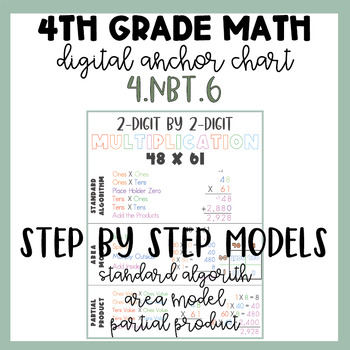2-digit by 2-digit Multiplication Anchor Chart | Partial Product | Area Model
- PDF
What educators are saying
Also included in
- Introducing our comprehensive Fourth Grade Math Mega Bundle – your one-stop solution for mastering all the fourth-grade math standards! This bundle combines all the digital step-by-step instruction products from our collection, offering a treasure trove of resources to support your students' math lePrice $63.00Original Price $71.50Save $8.50
- Enhance your math instruction with our comprehensive 4th Grade Numbers & Operations in Base Ten Anchor Charts BUNDLE. This set includes 15 anchor charts covering all key concepts of the 4.NBT standards, making it an essential resource for any 4th-grade math classroom. Perfect for visual learnersPrice $17.00Original Price $24.00Save $7.00
Description
Enhance your students' understanding of 2-digit by 2-digit multiplication with this detailed Anchor Chart! Aligned with CCSS 4.NBT.6, this anchor chart provides clear, visual instructions for solving multiplication problems using the standard algorithm, area model, and partial product method. Ideal for both digital and print use, this resource is perfect for reinforcing multiplication skills in your classroom.
What's Included:
- Anchor Chart for 2-Digit by 2-Digit Multiplication: Detailed steps for solving multiplication problems using three methods.
- Visual Aids: Clear illustrations to help students grasp complex concepts.
- Step-by-Step Instructions: Color coded guides for the standard algorithm, area model, and partial product method.
- Digital and Printable Versions: Use in digital classrooms or print for physical displays.
- Planogram: Trace this from a TV or projector onto an anchor chart paper to display and move around your classroom.
Key Features:
- Aligned with Common Core Standards: Supports CCSS 4.NBT.6 for multiplication.
- Visual Learning Aid: Enhances student understanding through clear visual representations.
- Versatile Use: Ideal for classroom displays, student reference sheets, and digital learning.
- Engaging Design: Keeps students engaged and makes learning multiplication fun.
Perfect For:
- Elementary and Middle School Teachers: Simplify the teaching of multiplication.
- Math Intervention: Provide extra support for students who need it.
- Homeschooling: Use as a visual aid to enhance math lessons at home.
- Tutoring: A valuable resource for math tutors working with students on foundational skills.
Tags: Operations and Algebraic Thinking Standards, Factors, Multiples, Factor Pairs, Skip Counting, Count Bys, Prime and Composite, Least Common Multiple, Greatest Common Factor, 4.OA.4, Fourth Grade Math, Measurement and Data Standards, Metric Conversions, Standard Conversions, Convert Using Division, Convert Using Multiplication, Metric Ladder, Length Conversions, Capacity Conversions, Weight Conversions, Time Conversions, Distance Learning Resource, Planogram Anchor Chart.





